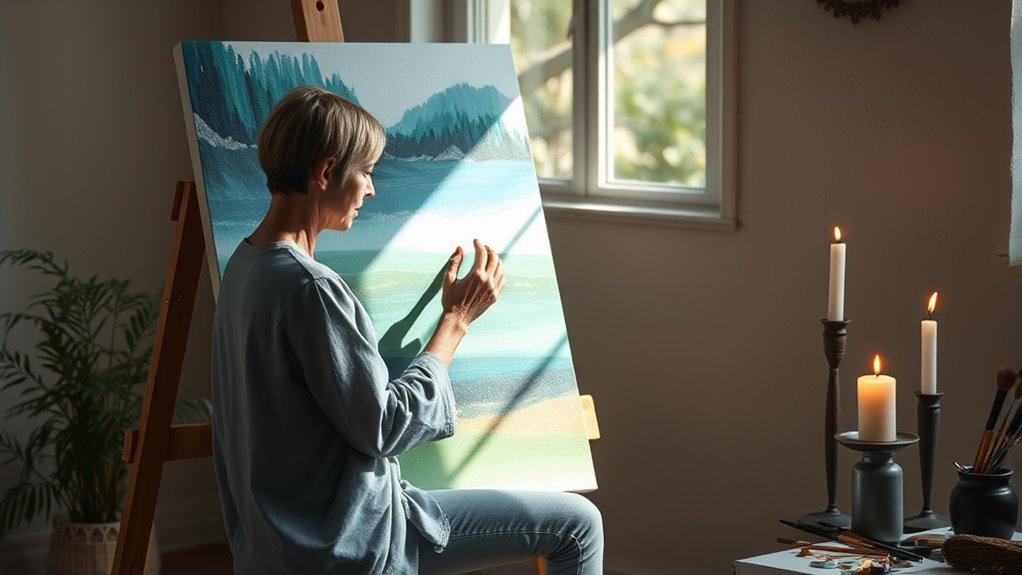Mindful art turns painting into a form of meditation by encouraging you to focus fully on the present moment. As you choose colors and apply brushstrokes with intention, you cultivate calmness, emotional awareness, and self-discovery. Paying attention to textures and sensations helps anchor your mind, fostering inner peace. When you approach art this way, it becomes more than creating—it’s a practice of mindfulness and emotional growth. Keep exploring this connection to uncover deeper insights.
Key Takeaways
- Engaging in mindful art fosters present-moment awareness, transforming painting into a meditative practice.
- Focusing on color choices and sensory details enhances emotional awareness and deepens mindfulness during creation.
- The process encourages non-judgmental expression, promoting calmness, clarity, and emotional processing.
- Emphasizing the act of painting over the outcome cultivates patience, acceptance, and inner peace.
- Art serves as a grounding tool, helping maintain presence and emotional balance amid life’s chaos.

Have you ever wondered how art can help you stay present and centered? Engaging in mindful art allows you to connect deeply with the moment, fostering a sense of calm and clarity. When you start painting with intention, you’re not just creating images—you’re practicing a form of meditation that invites you to focus on the here and now. One powerful way to deepen this experience is by exploring color theory. As you select colors, you become more aware of their influence on your mood and emotional state. Bright yellows can lift your spirits, while calming blues might help you find tranquility. By consciously choosing colors, you tune into your feelings and allow your emotional expression to flow freely onto the canvas. This process helps you recognize and process emotions without judgment, transforming painting into a therapeutic act.
Color theory isn’t just about aesthetics; it becomes a tool for emotional exploration. As you mix hues and experiment with shades, you’re engaging your senses and training your mind to stay present. This heightened awareness fosters mindfulness, as your focus narrows to the act of applying paint and the sensations it evokes. You may notice how the texture of your brushstrokes or the way colors blend affects your emotional landscape. This attentive process helps you detach from worries or distractions, anchoring you firmly in the current moment. Additionally, understanding the significance of precious metals in investments can inspire a mindful approach to financial security, encouraging careful planning and awareness of your long-term goals. The act of choosing and applying colors becomes a form of emotional expression, giving voice to feelings that might be difficult to articulate otherwise. Over time, this practice can deepen your emotional understanding and provide a safe outlet for self-reflection.
In mindful art, the emphasis is on process rather than outcome. As you allow yourself to experiment with colors and forms, you cultivate patience and acceptance. The focus shifts from perfection to presence, and each stroke becomes an act of mindfulness. You learn to observe your thoughts and emotions as they surface, acknowledging them without resistance. This openness transforms your painting session into a meditative practice, where creativity and awareness intertwine. Through intentional use of color and emotional expression, you create a space for self-discovery and inner peace. The more you practice this mindful approach, the more you’ll find that art becomes a powerful tool to help you stay grounded amid life’s chaos, encouraging a gentle, sustained connection with yourself.
Frequently Asked Questions
How Does Mindful Art Differ From Traditional Painting?
Mindful art differs from traditional painting by emphasizing mindfulness versus creativity, focusing on present-moment awareness rather than the final product. You engage in emotional expression through slow, deliberate brushstrokes, letting go of judgment and expectations. Rather than aiming for perfection, you immerse yourself in the process, fostering calm and self-awareness. This approach transforms painting into a meditative practice, helping you connect deeply with your feelings and the present moment.
Can Beginners Benefit From Mindful Art Practices?
Absolutely, beginners can benefit from mindful art practices, like planting seeds in a garden of emotional expression. You’ll find that this approach nurtures your creative confidence, helping you explore feelings without judgment. As you focus on the process rather than the outcome, you’ll discover a calming, empowering space to express yourself. Mindful art acts as a gentle guide, encouraging growth and self-awareness at any skill level.
What Materials Are Best for Mindful Painting Sessions?
You should choose simple, non-toxic materials like watercolor or acrylic paints for mindful painting sessions. Opt for brushes that feel comfortable in your hand, such as soft round brushes or flat brushes, to help you focus on the process. Use colors that inspire calm or curiosity, and practice slow, deliberate color mixing to stay present. The right materials enhance your meditative experience and make your mindful art practice more enjoyable.
How Long Should a Mindful Art Session Last?
A mindful art session should last about 20 to 30 minutes, allowing you to fully engage in art therapy and creative expression without feeling overwhelmed. Longer sessions can be beneficial if you’re comfortable, but starting with this timeframe helps maintain focus and presence. Use this time to relax, connect with your inner feelings, and enjoy the process, making mindfulness a natural part of your artistic journey.
Are There Specific Techniques to Enhance Mindfulness in Art?
Yes, you can enhance mindfulness in art by practicing breathing exercises before starting and staying aware of your sensory experiences as you paint. Focus on your breath and notice textures, colors, and sensations without judgment. Let each stroke be deliberate. This helps you stay present, deepen your connection to the process, and cultivate a calm, focused mindset. Regular practice amplifies these benefits over time.
Conclusion
As you embrace mindful art, painting becomes more than just a creative act—it transforms into a meditative practice that reduces stress and boosts mental clarity. Did you know that 75% of people who engage in mindful activities report feeling calmer and more focused? So, next time you pick up your brush, remember you’re not just creating art; you’re nurturing your well-being. Let your strokes become a daily ritual for peace and mindfulness.









